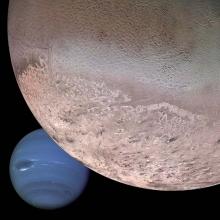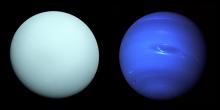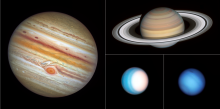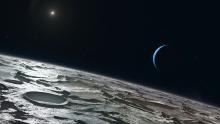You are here
Neptune's Triton

Triton, the largest satellite of Neptune, orbits in the opposite direction from most moons, suggesting that Neptune captured it in the distant past. Millions of years from now, Triton will move so close to Neptune that tidal forces will rip Triton apart, forming bright new rings around the giant planet.
Most of what we know about Triton came from Voyager 2, which photographed a landscape that is tinted subtle shades of pink, brown, and blue. Much of it resembles a cantaloupe, with ridges thousands of feet tall. Flowing ice or vaporizing gas may have carved this wrinkly terrain.
Voyager's most intriguing discovery was the geysers. Icy material jets about five miles high; above that, winds blow it parallel to the surface before it settles. Voyager found large dark streaks on Triton's surface that may have been created by other geysers over the past few thousand years.
Triton may get even more interesting over the next few years because one of its poles is warming up. Ice should vaporize, making the atmosphere thicker. The thicker atmosphere and higher temperatures on Triton could create more and bigger geysers, and spread their plumes over larger regions of this frigid moon.
Keywords
At a Glance
| Triton At a Glance |
|---|
| Discovered |
| 1846, William Lassell |
| Diameter |
| 1,680 miles 2,704 km |
| Distance from Neptune |
| 220,438 miles 354,760 km |
| Orbital Period |
| 5.9 days |
Teacher Copies
Request a free copy of The Solar System or Beyond the Solar System for your classroom. Bulk copies are available for $1.50 each in quantities of 30 or more. Shipping is included. Call 512-471-5285 for orders of 30 or more.
 The Astro Guides for the Solar System and Beyond the Solar System are supported by the National Aeronautics and Space Administration under Grant Nos. NNG04G131G and NAG5-13147, respectively.
The Astro Guides for the Solar System and Beyond the Solar System are supported by the National Aeronautics and Space Administration under Grant Nos. NNG04G131G and NAG5-13147, respectively.






